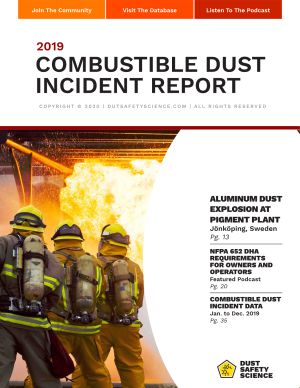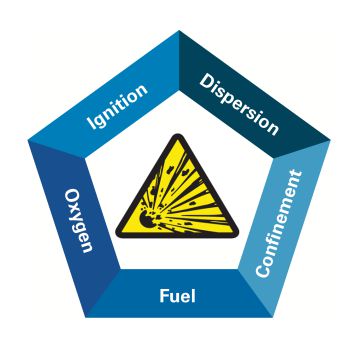Dust Hazard Analysis
We will help you determine if you have combustible dust and what to do about it.
What is a Dust Hazard Analysis?
A Dust Hazard Analysis (DHA) is comprised of a series of tests to determine the presence of a combustible dust hazard within a facility. Each test builds upon results from previous tests and defines a more accurate understanding of the type of dust hazard present and a risk assesment of a combustible dust explosion. The Dust Hazard Assesment or Analysis includes recommendations to minimize the possibility of an explosion or proposes adjustments to existing dust collection system to safely isolate or suppress flames and pressure in the event of a combustible dust explosion.
Why You Need a Dust Hazard Analysis?
Combustible Dust is a concern for all industries; A Dust Hazard Analysis is integral to determining combustible dust hazards present in your facility and can help shape a plan, create processes, and develop procedures to mitigate combustible dust explosions as part of your overall process safety protocols.
There is a growing feeling of inevitability amongst business owners and local firefighters that combustible dust-related fires and combustible dust explosions are just “the nature of the industry” until a catastrophic fire or explosion occurs. A Dust Hazard Analysis is the first step in preventing these disasters and understanding that combustible dust explosions are not inevitable.
Who Needs a Dust Hazard Analysis
All existing facilities handling combustible dust must have a DHA completed by September 7, 2020, in compliance with the NFPA 652 Standard
Industries Affected
A DHA differs from the more complex Process Hazard Analysis (PHA) used by industries such as refineries and chemical manufacturing. A dust hazard analysis and risk assessment is a less-strict procedure required for all industries where dust is created.
When to do a DHA
Warning Signs
Facilities, where small fires are routinely put out by employees or local firefighters, have been called to the scene to deal with a small fire are at greater risk to have a catastrophic combustible dust explosion.
Modifications to Existing Processes
Any modification to an existing process with costs that exceed 25% of the original installation costs requires a DHA.
Addition of New Processes
Any new processes added to your facility must have a Dust Hazard Analysis within 3 years to comply with the NFPA 652, 2016 Edition Standard.
NFPA 652 Compliance
The NFPA 652 Standard on the Fundamentals of Combustible Dust, 2016 Edition, has been in effect since July of 2015. This standard promotes awareness of hazardous dust and defines hazard analysis, management and mitigation. NFPA 652 introduced the concept of a Dust Hazard Analysis (DHA) as an adjunct to other forms of process safety.
Timeframe for Compliance
The deadline for compliance with NFPA 652 is September 7, 2020. All industrial facilities must complete a Dust Hazard Analysis by this date.
The NFPA 652 standard applies retroactively to all facilities. Any upgrades or new installations must perform a DHA within 3 years to comply with this standard.
What are your responsibilies
The NFPA 652 standard makes the owner/operator of the facility responsible for:
- Characterizing combustible materials
- Identifying hazards.
- Mitigating those hazards.
- Communicating hazards to the workforce.
Risk Factors
Industries Most at Risk for Dust Explosions
According to the Canadian Centre for Occupational Health & Safety (CCOSH), industries where combustible dust poses a greater risk are:
- Grain elevators
- Food production
- Chemical manufacturing (e.g. rubber, plastics, pharmaceuticals)
- Woodworking facilities
- Metal processing (e.g. zinc, magnesium, aluminum, iron)
- Recycling facilities (e.g. paper, plastics, metals)
- Coal-fired power plants.
Materials Most at Risk for Dust Explosions
Industries using these materials pose a greater risk:
- agricultural products such as egg whites, powdered milk, cornstarch, sugar, flour, grain, potato, rice, etc.
- metals such as aluminum, bronze, magnesium, zinc, etc.
- chemical dusts such as coal, sulphur, etc.
- pharmaceuticals
- pesticides
- rubber
- wood
- textiles
- plastics
What a Dust Hazard Analysis can Tell You
On-site Dust Hazard Analysis
A Combustible Dust Hazard Analysis or Assessment (DHA) is a comprehensive look at your dust within the complete framework of your workplace, its operations and equipment. It can help in the determination of both explosion severity and ignition sensitivity. It can determine and characterize hazard risks of dust in the framework of your facility and help in developing a mitigation strategy for any potentially hazardous, explosive or combustible dust.
If it is determined a potential dust-hazard threat exists, then the next step would be a Go/No-Go Test as outlined below.
Go/No-Go Test
The Go/No-Go test is a simple cost-effective test that screens for the possibility of dust explosibility in your facility. This test can also tell you the minimum temperature at which your dust layer will ignite, i.e. the minimum Autoignition Temperature (MIT) of a dust cloud in the air.
If the Go/No-Go Test is a “Go”, i.e. your dust is combustible, then further Combustible Dust Testing can be done
Combustible Dust Testing
To truly understand the risks a combustible dust poses to your workers and facility, a series of tests can be performed to determine the best ways to mitigate possible disastrous complications of a dust explosion. These tests include explosivity, explosion severity, ignition sensitivity and more.

AST Canada has been helping clients find solutions for their unique Dust, Mist & Fume Collection needs for more than 40 years.
We can help you too.



